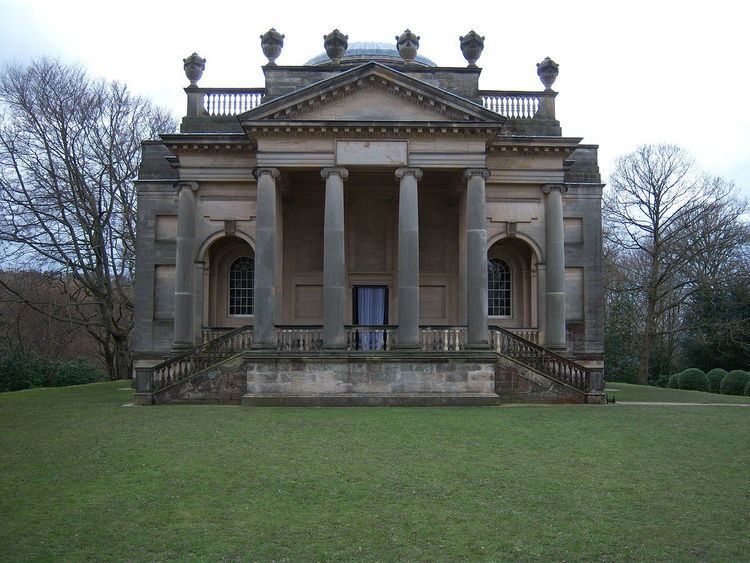Phone +44 1207 541820 | ||
 | ||
Hours Closed now Monday10AM–4PMTuesday10AM–4PMWednesday10AM–4PMThursday10AM–4PMFriday10AM–4PMSaturday10AM–4PMSunday10AM–4PM Similar Saltwell Park, Tanfield Railway, Shipley Art Gallery, Gateshead Millennium Bridge, Cragside Profiles | ||
Gibside is an estate in the Derwent Valley, between Rowlands Gill, Tyne and Wear and Burnopfield, North East England. Gibside was previously owned by the Bowes-Lyon family. It is now a National Trust property. The main house on the estate is now a shell, although the property is most famous for its chapel. The stables, walled garden and Banqueting House are also intact.
Contents
Beneath the cracks mary eleanor bowes and gibside hall
History
The Blakiston family acquired the estate by marriage in about 1540. Sir William Blakiston (1562–1641) replaced the old house with a spacious mansion between 1603 and 1620. Both the Royal (King James I of England) coat of arms and the Blakiston coat of arms are seen over the entrance of the old Hall. The Gibside property came into the possession of the Bowes family in 1713; a result of the marriage between Sir William's great granddaughter, Elizabeth Blakiston, to Sir William Bowes (1657–1707) of Streatlam Castle (now demolished) in 1693.
Until 1722, the basis of the Bowes' influence was their own estate and castle of Streatlam. However after that date the acquisition through marriage of the Blakiston estate gave the Bowes family an even greater influence in the north of the county and a share in the immense wealth that was to be acquired from the coal trade. The Blakiston estate included some of the area's richest coal seams.
In 1767 the granddaughter of Sir William Bowes – the "Bowes heiress" Mary Eleanor Bowes – married John Lyon, 9th Earl of Strathmore and Kinghorne, who changed his surname to Bowes due to a provision in her father's will that any suitor had to take the family name. This was a device to continue the Bowes lineage in the absence of a male heir.
Improvements to Gibside carried out by the Bowes-Lyon family included landscaping in the 18th century, a chapel (Gibside Chapel, built between 1760 and 1812), a banqueting hall, a column of Liberty, an avenue of oaks and several hundred acres of forest.
Gibside's main house is not the focal point of the estate: the long walk runs from the Column of Liberty to the chapel and the mansion is located to one side. The house became vacant in the 1920s after the Bowes-Lyon family sold some of its properties to pay death duties. The building was stripped of its fixtures and fittings, with many of the fireplaces and other items being transferred to Glamis Castle. Parts of the structure were demolished in 1958, including the removal of the roof, the remains are protected by Grade II listed building status.
Parts of the grounds have been designated a Site of Special Scientific Interest, including a forest garden that is currently under restoration. Several buildings including a Palladian chapel and others are awaiting or undergoing restoration.
The chapel and Grand Walk have been in the National Trust's ownership since 1965 and an additional 354 acres (1.43 km2) of the grounds were acquired in 1993. The Banqueting House has been in the ownership of the Landmark Trust since 1981, the building having been restored from a derelict shell.
Land army girls were billeted at Gibside during World War I.
Shared ancestry
Queen Elizabeth The Queen Mother – a direct descendent of Sir William Blakiston and thus the great great great granddaughter of Mary Eleanor Bowes – had fond memories of Gibside. During her youth, she had enjoyed trips with her father, Claude Bowes-Lyon, 14th Earl of Strathmore and Kinghorne to the estate, which was owned by her family. Both she and her husband, the Duke of York (later King George VI), visited the estate a number of times, the first time in July 1936 and the last being in 1968 when, as the Queen Mother, she made a private visit to the Gibside Chapel.
It was reported in 2014 that the direct ancestor of Catherine, Duchess of Cambridge, was Sir Thomas Blakiston Conyers, 9th Baronet (d.1810), who was the great great great grandson of Sir William Blakiston (d.1641) of Gibside. The Duchess and the Queen Mother – the great great great granddaughter of Mary Eleanor Bowes – are thus distant blood cousins; their common ancestor being Sir William Blakiston. This means therefore that the Duke and Duchess of Cambridge are distantly related. In 1800, Sir Thomas Conyers had attended the funeral of his cousin Mary Eleanor Bowes at Westminster Abbey. The link between the Blakiston and Bowes family is memorialised by the Blakiston-Bowes Cabinet of circa 1700, formerly in Streatlam Castle in County Durham, and now in the Metropolitan Museum of Art in New York.
